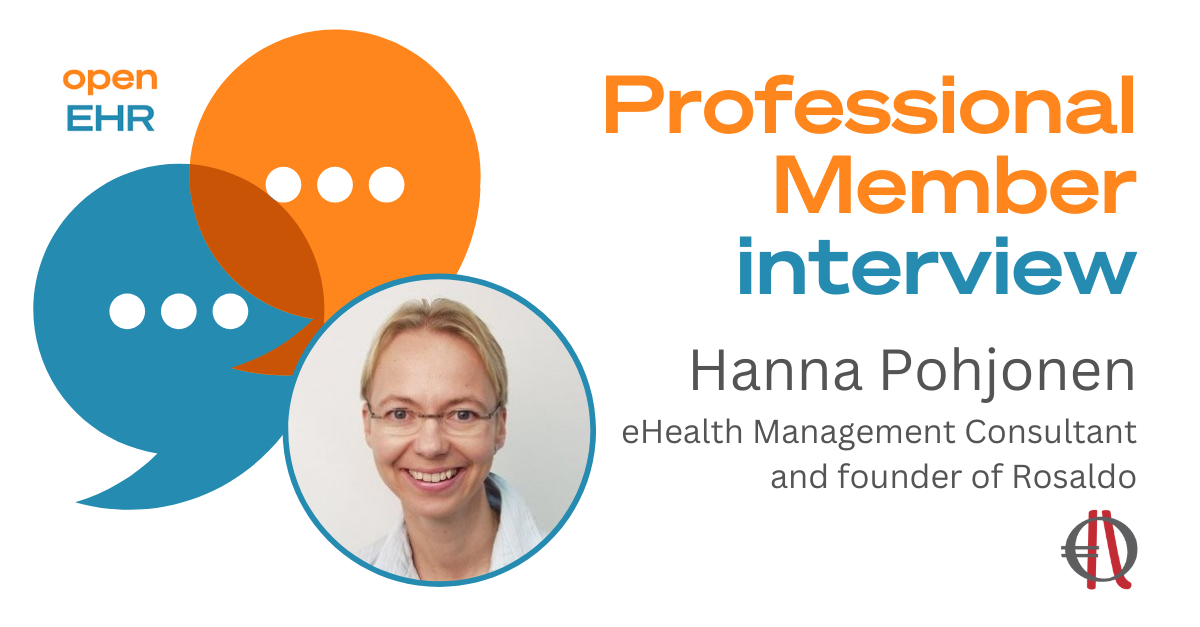Professional member of openEHR and co-founder of ehealth company, Rosaldo Oy in Finland.
I’m an eHealth management consultant and an educator and have been working in over 30 different countries all over the globe in data sharing and shared workflow projects for a long time. I started my openEHR eLearning programme when COVID hit, and when the borders closed, I thought I better do something online!
The reason I started this openEHR educational journey was my end customers were telling me that openEHR is too difficult, too theoretical, too technical…. They were like, ‘we want to have concise information that is understandable, clear content so that we can make decisions whether to invest in openEHR or not. Should we buy a monolith, or should we start the openEHR journey?’
My customers wanted to have practical information about the different perspectives. And I said to them ‘okay, what are your pain points? What do you want to know about openEHR?’ And I built the Awareness course around that – in an agile way – with the end users in mind so that they got what they wanted.
First I made it in Finnish and then after a couple of months people from abroad asked me to do it in English. So I did, and within the year, I was in twelve different countries. Today I have participants in even more: Finland, Sweden, Norway, Denmark, Estonia, UK, Belgium, Netherlands, France, Spain, Portugal, Slovenia, Germany, Italy, Nigeria, India, Japan…
How does the course work?
It’s comprised of training modules on an elearning platform: the idea is to avoid any long, boring network courses. So it’s a modular experience with short, concise information about different perspectives of openEHR. It’s very important that I talk about the market as well, what’s happening in different countries because people want to know how openEHR is being used in different markets and international projects. It’s also a social networking environment so you can communicate with the other participants in the same classroom, and you can ask me and the other course facilitators questions too.
There was a clear gap for understandable material about openEHR. And now the demand for information is growing. When people bought into the idea of openEHR, they asked for more detailed information about certain perspectives like technical architectures, clinical modelling, clinical decision support and so on. To answer this need – I collaborated with some other partners in the openEHR community: FreshEHR, Better and Cambio.
Today Rosaldo provides a true openEHR academy with six different courses! Many public organisations and companies offer this Academy to their employees to study at their own pace, but communicate with each other when appropriate. The different parts (courses) of the Academy are provided to different roles and responsibilities. It’s going really well.
How does openEHR compare to other standards?
They all have their use cases and purposes. In my Awareness course I talk about different open standards such as openEHR, HL7 FHIR and OMOP. I also discuss document-based data sharing, as in many countries document-based and structured sharing need to work together – complementing each other. You always need to take into account the history of the country and the history of data sharing; then you can evolve into something that is more modern but in a cooperative way.
We also need to take into account the legacy vendors: those who have older products, so if they start transforming to openEHR, they still need to serve their clients who have legacy products in place. I always say that you need to find the win-win situation and you need to support the legacy vendors, because sometimes I think that we tend to be too binary. It’s not all or nothing.
Another thing that I think is crucial – education-wise – is that it’s very easy to educate inside the openEHR community, because everybody has got the right mindset. But the challenge comes when you go outside the community: you have to educate the masses who may be very resistant to change. If we really want openEHR to be successful, we need to target education to people who don’t know anything about openEHR.
What do you see as the future for not just openEHR, but for EHR and interoperability?
If you look at Nordic countries, we are forerunners in open ecosystems: the dominant EHR players have already taken openEHR as their internal data model. That’s totally different from many other countries who have created openEHR-based data exchange, but EHR vendors still have their own internal data models. I hope that we will see more vendors adopt openEHR so that applications can understand each other’s data without any cumbersome conversions. It makes more sense for the vendors to focus on the functionalities than building their own proprietary data models. This already happened in the imaging industry a long time ago with the adoption of Dicom as the harmonised data model.
Everybody should use the same data model, and then the functionalities of applications should be the key differentiators in the competition.
Is there anything more that you would like to see from openEHR International?
I think it would be good if people could have access to more understandable material throughout all the web pages. If a tech company makes the decision to start the openEHR journey, then they go to the specifications, and it can be quite daunting. So we need to maybe lower the threshold there.
What are the benefits of being a member of the openEHR community?
I personally benefit from the network of various organisations and experts. The openEHR community is very friendly and even if we sometimes compete, we also collaborate. Everyone believes in openEHR. I also collaborate with other members to produce the content in the Rosaldo openEHR eLearning environment.

Leave a Reply